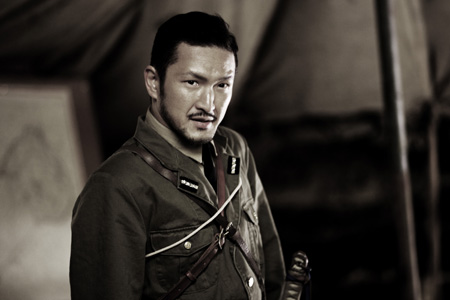|
Reviews of Recent Independent, Foreign, & Documentary Films in Theaters and DVD/Home Video
Directed by: Clint Eastwood. Written by Iris Yamashita, story by Iris Yamashita & Paul Haggis. Produced by: Clint Eastwood, Steven Spielberg & Robert Lorenz. Director of Photography: Tom Stern. Edited by: Joel Cox & Gary D. Roach. Music by: Kyle Eastwood & Michael Stevens. Released by: Warner Brothers/DreamWorks. Language: Japanese with English Subtitles. Country of Origin: United States. 141 Minutes. Rated R. With: Ken Watanabe, Kazunari Ninomiya, Tsuyoshi Ihara, Ryo Kase, Shidou Nakamura, & Nae.
As its Rashomon-like mirror image, Letters from Iwo Jima opens where Eastwood’s earlier Flags of Our Fathers had ended, at the memorial to those who died at Iwo Jima – 7,000 Americans and over 20,000 Japanese. The story by Iris Yamashita and Paul Haggis uses a somewhat gimmicky narrative device of Japanese soldiers writing the titular farewells to their families, as discovered in a recent archaeological dig, with the following voice-overs and flashbacks.
U.S. war movies have never gone beyond caricatures of fanatics in explaining how the Japanese could fight so ferociously on this island and others
in the Pacific theater. Even their cries of “Banzai!” here are not shown as the bluster of the usual strutting automatons, but as coming from a
deeply felt shared ritual and tradition. Lieutenant Ito (Shidou Nakamura) at first seems the usual tin star despot of countless war films, but he is more and more seen against the backdrop of an ideology emphasizing devoted sacrifice, driving him to insist on actions that seem pyrrhic compared to Americans’ fighting for their comrades.
Sensitively depicted are the reminiscences of Baron Nishi (played with dashing élan by Tsuyoshi Ihara), who was the actual equestrian gold medal winner in the 1932 Los Angeles Olympics, and Lt. Gen. Tadamichi Kuribayashi (Ken Watanabe, further stepping into Toshiro Mifune’s shoes), who had been a military attaché in Washington D.C. The general traveled widely throughout North America and wrote illustrated letters home to his family, which were published posthumously, inspiring Yamashita’s script. While his American experiences make his rebellious conservative officers vocally suspicious of his loyalty, his first-hand experiences seeing the industrial might of the U.S. leads him to brush aside the Japanese army’s usual plans of defense. Over continuing protests, he initiates the innovative construction of an astounding network of tunnels, caves and fortified redoubts, a fierce underground defense that shocked the invading force, as was so viscerally seen in Flags.
But the tactics are covered quickly through the first somewhat conventional 45 minutes or so that leisurely introduces each of the characters. The heart of the matter is reached when General Kuribayashi realizes there will be no naval and air support, and he is directed to defend the first bit of “sacred land” the United States will invade (Iwo Jima lies 700 miles south of Tokyo). His admonition to take down 10 Americans each before dying takes on heightened meaning as his men are beset by dysentery and run out of water, food, and ammunition. One by one the soldiers debate when and how to die. Gripping battle scenes alternate with these intensely intimate moments.
Tom Stern’s cinematography in that hauntingly desolate landscape (where the volcanic rock of Iceland is a ringer for Iwo Jima) was the
outstanding element in Flags, and he goes even further in subtle processed shadings here (the Japanese flag is always shown with the red
sun rising). The most noteworthy music is a heartbreaking piano riff that is evocatively repeated.
However, the time frame is a bit confusing and has to be indirectly inferred. It is also surprising that producer Steven Spielberg’s Munich had
superbly clear-to-read subtitles, but the old-fashioned looking ones here are frequently white-on-white. Fortunately, the bulk of the film takes place in dark settings.
It is certainly not necessary for following this film to see the American half of the whole, even though a few brief scenes are seen or explained
from both perspectives. But together they provide a uniquely 360 degree view of how men rise to nobility in war, regardless of the reasons they get
manipulated into that situation by their governments or how their heroism gets cynically used. After one viewing, this masterpiece packs a wallop.
Nora Lee Mandel
|

